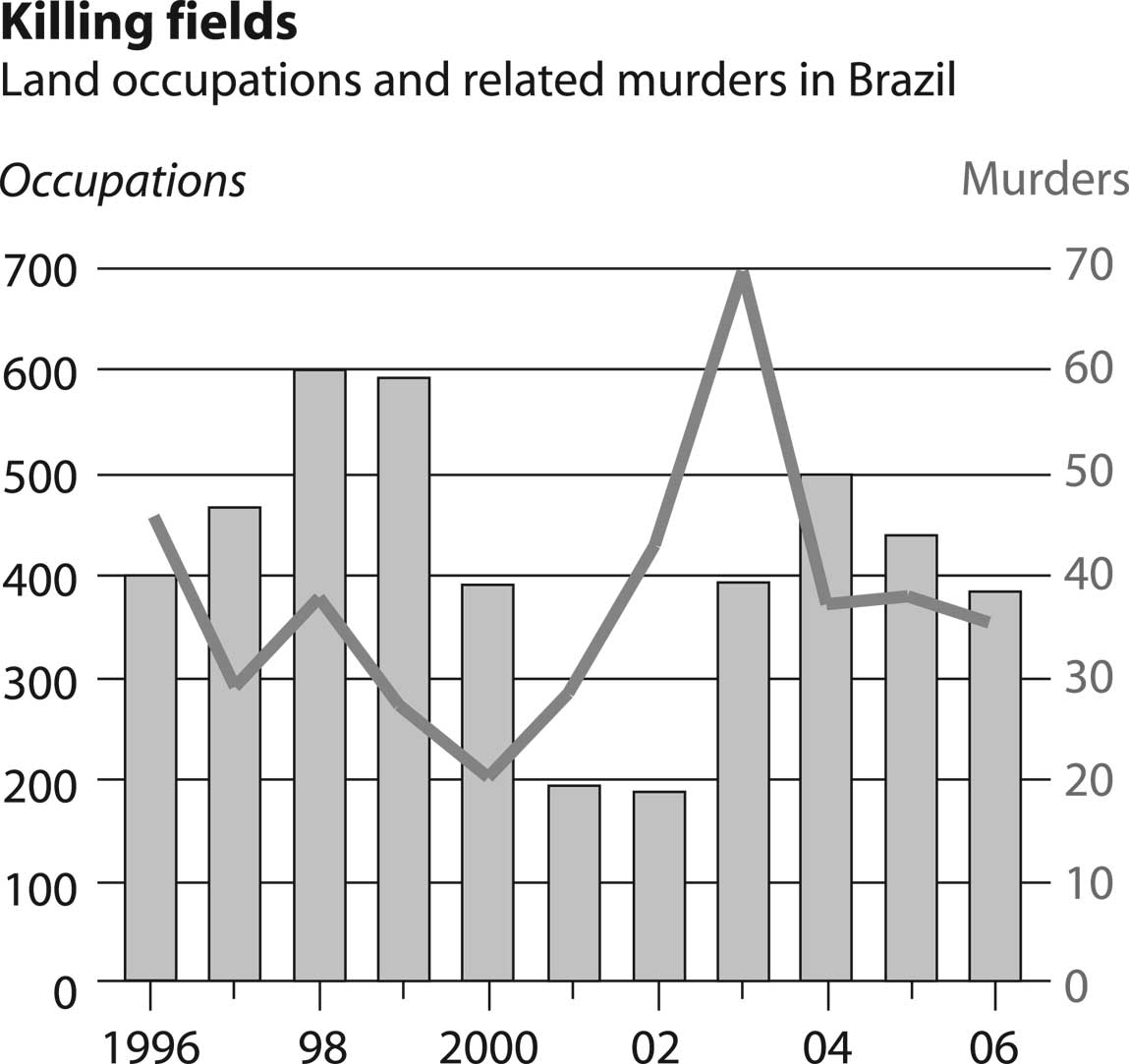Box 1-1. The MST and land tenure in Brazil
Since the early 1980s more than one million people in Brazil have
transformed their lives by gaining access to land. This has been
possible thanks to a strategy of organizing and peaceful protest
that has forced the government to redistribute more than eight
million ha of cropland to some 350,000 families and help them
develop new ways of life. These families belong to what many call
the largest social movement in Latin America and the Caribbean,
the Movement of Landless Rural Workers (MST: Movimento dos
Trabalhadores Rurais Sem Terra).
The MST’s strategy is based on forcing the government to enforce
the law. For almost five centuries Brazil has been plagued by
major economic inequality, in particular with respect to land tenure.
Large estate owners have controlled vast rural areas with impunity,
in some cases by falsifying documents and in others by recourse to
violence (see figure). Much of this land is not used efficiently and has
resulted in stagnant development in rural areas. To combat this
problem, since the early 19th century successive governments
promoted the idea that to claim legal title to property, an owner
must show that the land is serving a “social function.” Today this
concept has been incorporated into the Brazilian Constitution.
Brazil is an emerging economy, and also the eighth largest economy
in the world. Nonetheless, most Brazilians live in poverty. It has
the most stark economic inequality in the world, as well as very unequal
land distribution (the Gini coefficient for land distribution was
0.85 in 1994). For example, 3% of the landowners hold two-thirds of
the country’s arable lands. The highest levels of poverty and illiteracy
are in rural areas, where the main problem is land tenure.
The MST has 1.5 million members in 23 of Brazil’s 27 states.
Today, there are 2,000 MST settlements and more than 80,000 additional
people are currently living in camps awaiting government
recognition. Cooperative farms, houses, schools for children and
adults, and clinics have been built in these settlements.
According to the MST, its success is based on its ability to organize
and educate. The members gain access to land, and therefore
to food security for their families; in addition, many of them continue
to participate in the design of a sustainable socioeconomic development
model that offers specific alternatives to the model of neoliberal
globalization. Some of the results of the organizational efforts of
the MST with respect to production and marketing include:
• 400 associations of small-scale producers in the areas of production,
marketing, and services. These include:
— 49 farming and ranching cooperatives
— 32 service cooperatives
— 2 regional cooperatives for marketing
— 3 credit unions
• 96 small- and medium-scale cooperatives for processing fruits,
vegetables, dairy products, coffee, cereal grains, meat, and sugar.
These economic enterprises of the MST generate employment
and salaries that directly or indirectly benefit 700 small towns in
the Brazilian interior.
The leaders of the MST argue that production cannot be considered
in isolation from education; accordingly, many of its programs
are geared to educating its members. Results of the MST’s
organizing efforts with respect to education include: |
|
• 160,000 children are studying in grades 1 through 4 in public
schools located in MST settlements
• 3,900 educators paid by the local (municipal) governments are developing teaching methods specifically tailored to the
MST’s rural schools
• In collaboration with UNESCO and some 50 universities, the
MST is developing literacy programs for some 19,000 adolescents
and adults in the settlements
• In collaboration with several Brazilian universities, training is
being provided to teachers, administrators of settlements and
cooperatives, and nurses
• In collaboration with the government of Cuba, 48 members of
the MST are studying medicine in Cuba
The MST is also promoting sustainable development. For example:
• In 1999, members of the MST developed Bionatur seeds for
organic production.
• Several settlements are involved in the production of medicinal
plants.
• In Pontal do Paranepanema, families from the settlements work
together with environmental organizations to conserve the forest.
The MST is not free of controversy. Its critics assert that the members
are mainly people from cities who ended up in worse living conditions
than the urban areas they left. It is also argued that the establishment
of settlements in the Amazon region has contributed to deforestation.
Nonetheless, a recent survey (cited by The Economist, 2007) revealed
that 94% of those living in settlements have prior agricultural experience,
and 79% stated that their lives had improved as a result of
having obtained land and joining the MST. The MST argues that its
activities in the Amazon region are mainly in areas already deforested,
particularly relatively unproductive cattle ranches.
Independent of the controversy that surrounds the MST, one
cannot question the impact that this social movement has had in
Brazil, or its influence on the rest of Latin America and the Caribbean.
The successes and failures of this massive movement may
serve as an example for the governments and social movements
of the other countries of the region as they seek to solve the problems
associated with the stark inequalities in land tenure in LAC.

|